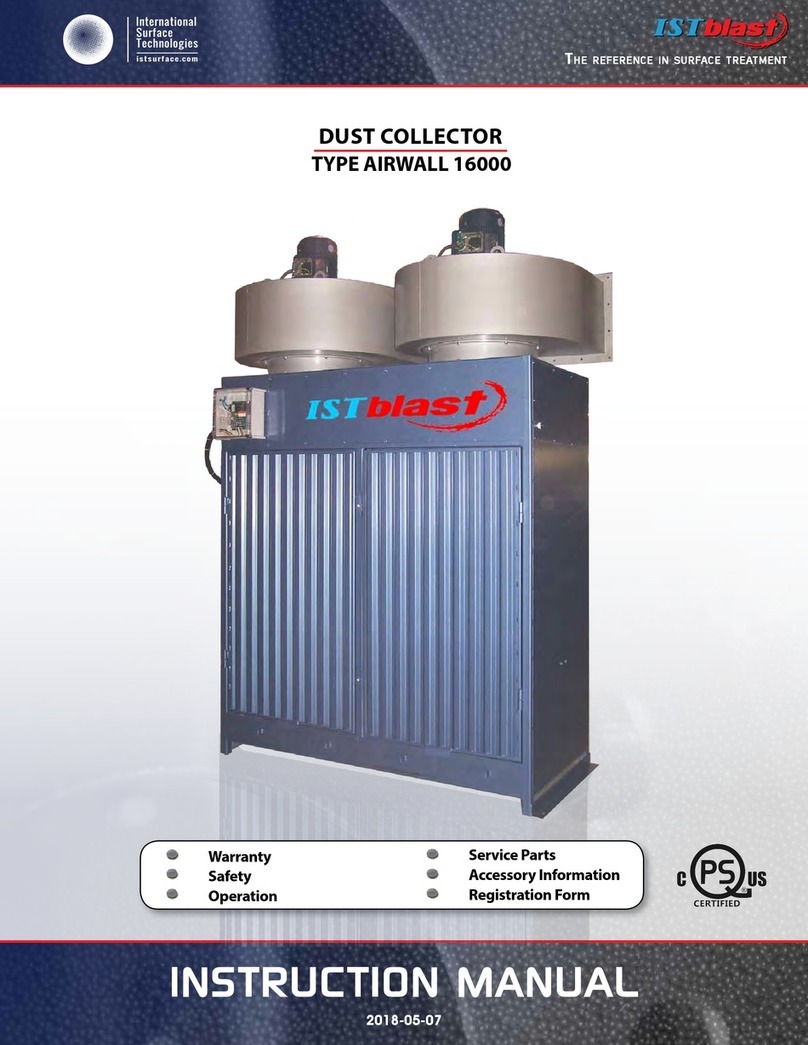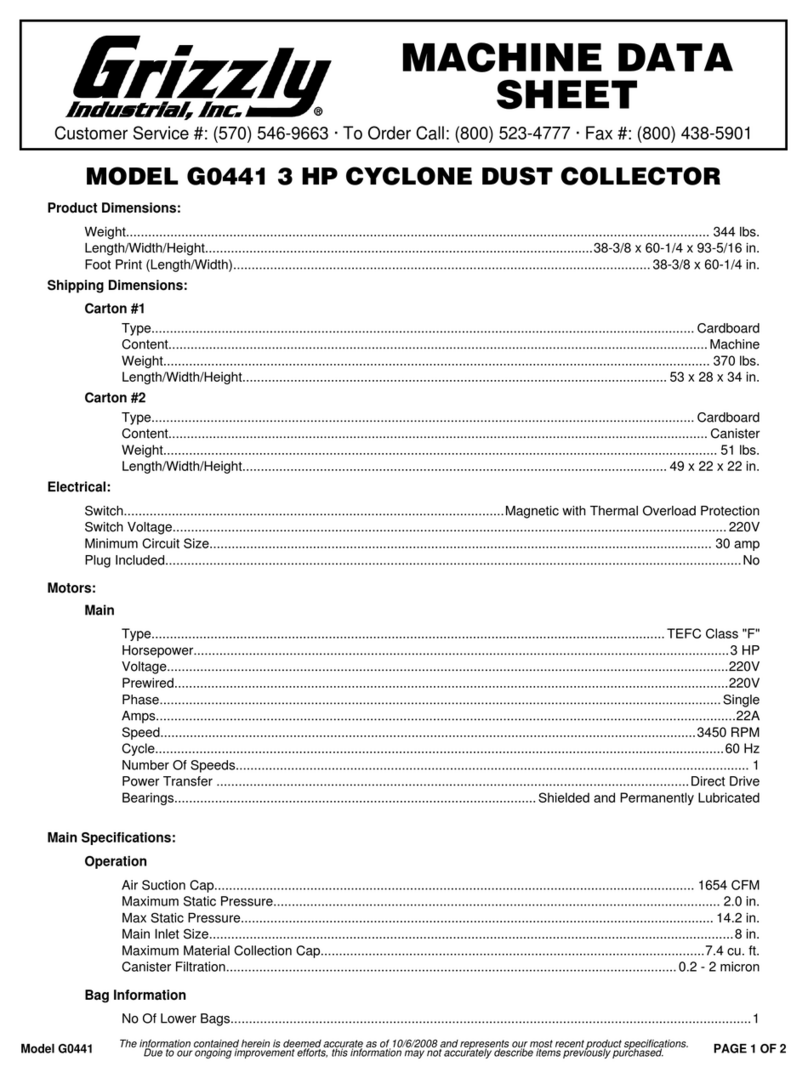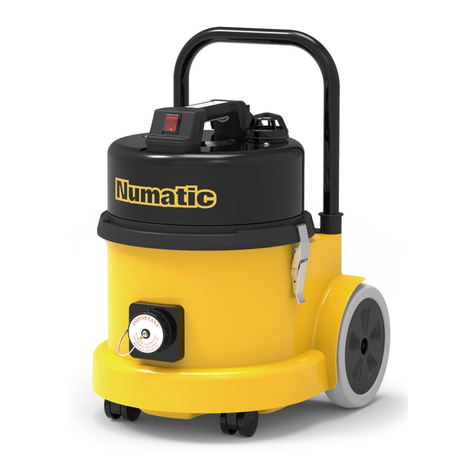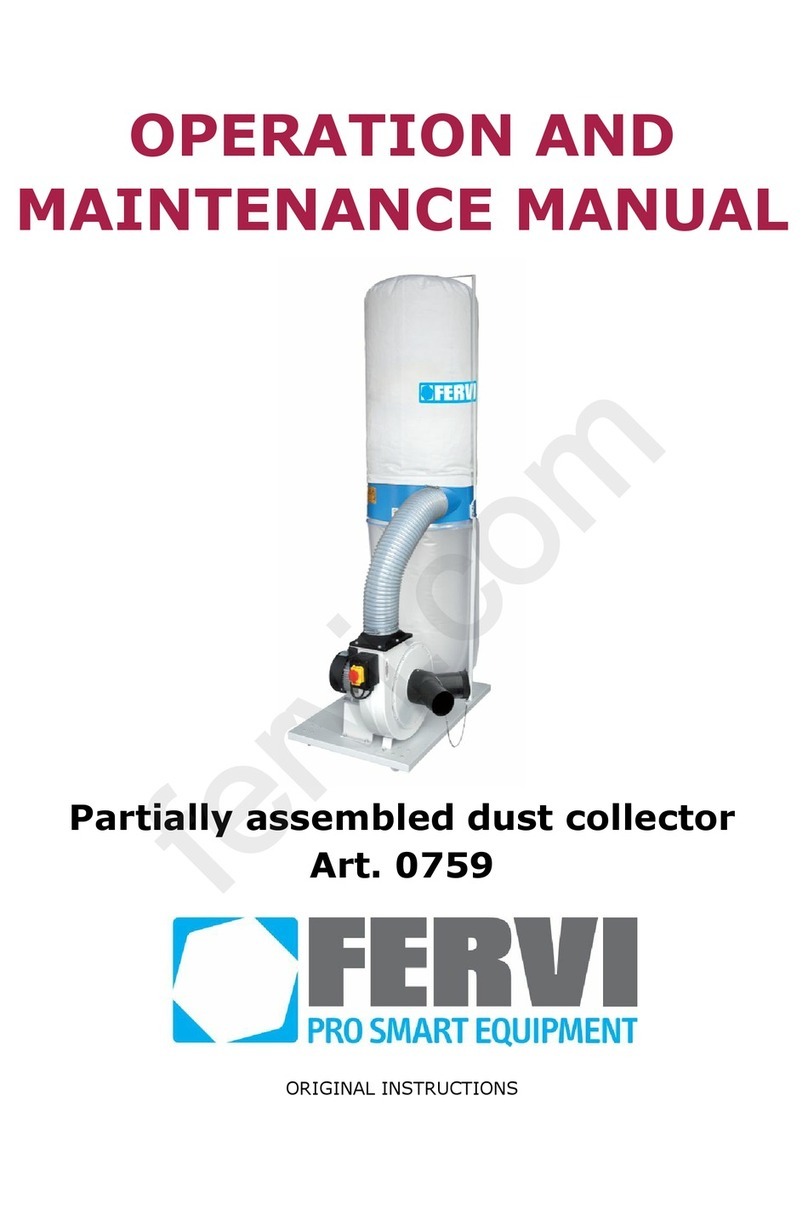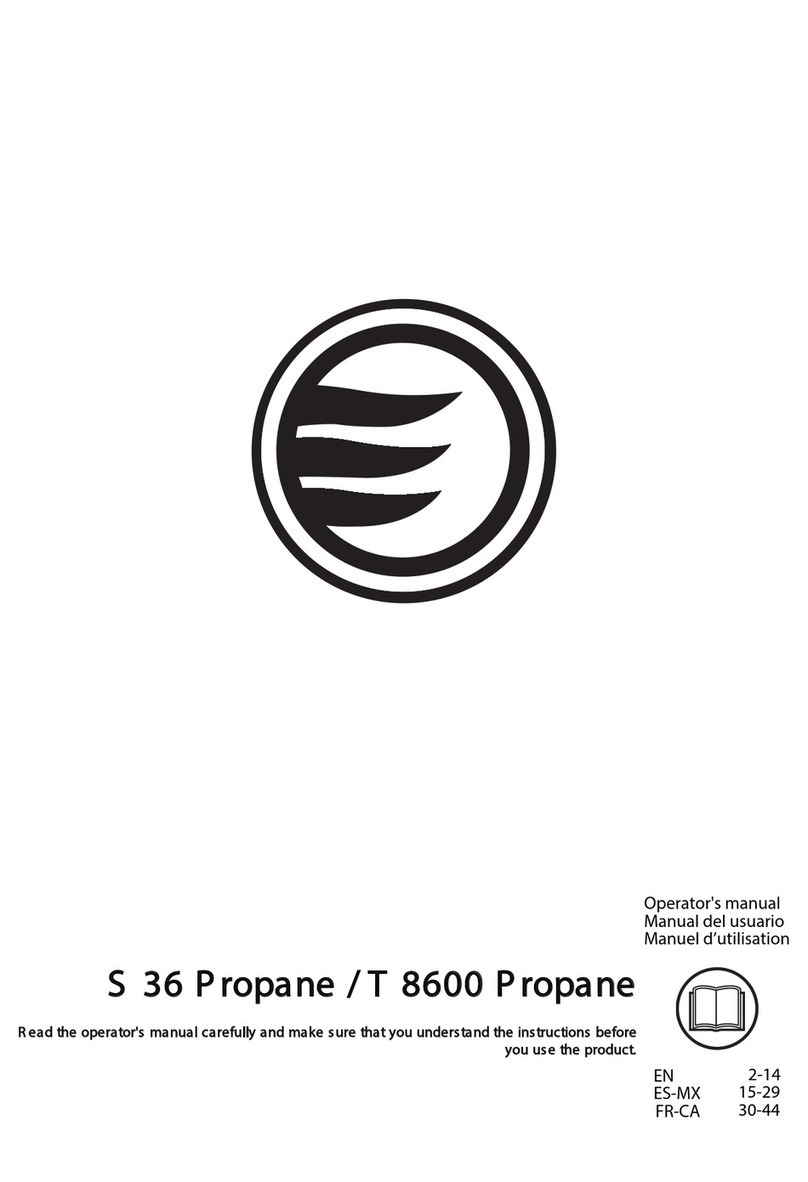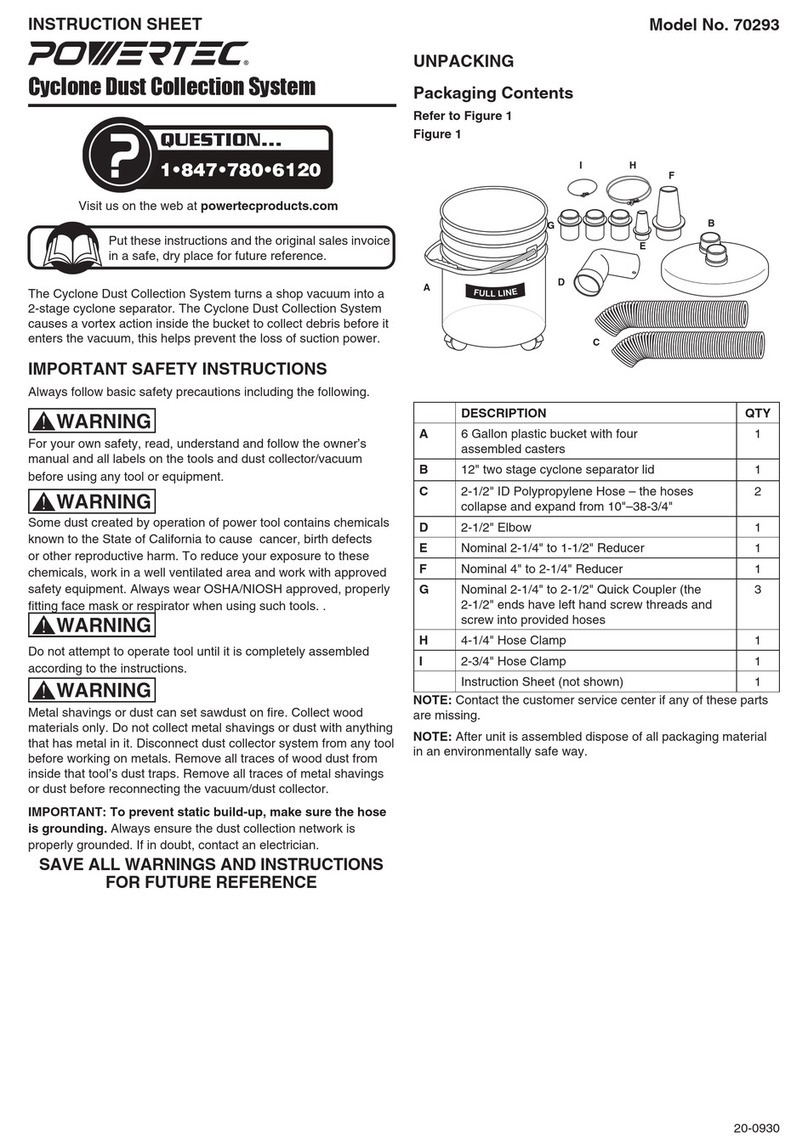Esta TK-4 User manual

The World of Extraction
OPERATING INSTRUCTIONS
OM/TK/OMF
Mini Dust Collector
C
E
R
T
I
F
I
E
D
I
S
O
9
0
0
0
:
2
0
0
8
QUALITY

Your purchase of an ESTA machine has
been a good decision. The design of
our quality products complies with the
latest state of the art. ESTA products
have been devised to provide for clean
air at the workplaces at which they are
applied. This results in an even more
enhanced level of quality and longer
machine times and, particularly, healthier
working conditions. Should you have
any questions pertaining to suction tech-
nology issues, please feel free to contact
us at any time. Our experts will be gladly
at your disposal.
Your ESTA Absaugtechnik Team
The World of Extraction
www.esta.com
Welcome to the sphere of suction
technology

Installation instructions
TK / OM / OMF
Item No. 31.041 (TK-4)
Item No. 31.061 (TK-6)
Item No. 41.032 (TK-H)
Item No. 41.033 (TK-2.2)
Item No. 21.081 (OM-8)
Item No. 21.101 (OM-10)
Item No. 21.122 (OM-12)
Item No. 21.127 (OM-12 S)
Item No. 21.308 (OMF-8)
Item No. 21.310 (OMF-10)
Item No. 21.312 (OMF-12)
Do not use this device unless you have
read theiInstallation instruction and understand it.
Translation of the original installation instructions
31061-08-05

2
TK/OM/OMF
31061-52-05
Edition notice
Original installation instructions
Document No.: 31061-08-05
Publishing date: 26.04.2017
Type of device: TK // OM // OMF stationary extractor
Item No.: 31.041 // 31.061 // 41.032 // 41.033 // 21.081 // 21.101 // 21.122 // 21.127 //
21.308 // 21.310 //21.312 and variations
Publisher
ESTA Apparatebau GmbH & Co. KG Tel.: +49 (0) 73 07 80 4 -0
Gotenstraße 2-6 Fax: +49 (0) 73 07 80 4 -500
Germany www.esta.com
Copyright notice (per DIN ISO 16016:2007-12)
Transfer or reproduction of this document, or the use or communication of its content, is
forbidden without explicit consent. Violators will be liable for damages. All rights to patent, utility
or design registration are reserved.
Warnings and safety instructions
Electrical current hazard
Note
Reference to ESTA customer service
Reference to legal regulations

31061-52-05
TK/OM/OMF
3
Contents
Contents .....................................................................................................................................3
1. General safety notes ...........................................................................................................4
2. Preventing mechanical hazards.........................................................................................6
3. Preventing electrical hazards.............................................................................................6
4. Preventing dust hazards.....................................................................................................6
5. Intended use ........................................................................................................................7
6. Technical data and description..........................................................................................8
6.1 Small dust extractor models ...............................................................................................8
6.1.1 TK....................................................................................................................................8
6.1.2 OM...................................................................................................................................8
6.1.3 OMF ................................................................................................................................9
6.2 Functional description.........................................................................................................9
7. Delivery, installation and start-up....................................................................................10
7.1 Delivery and transport ......................................................................................................10
7.2 Installation........................................................................................................................10
7.3 Start-up.............................................................................................................................11
8. Maintenance & troubleshooting.......................................................................................12
8.1 Maintenance instructions..................................................................................................12
8.2 Inspection and maintenance intervals .............................................................................13
8.3 Troubleshooting................................................................................................................14
9. Monitoring the minimum airflow volume.........................................................................15
10. Cleaning .............................................................................................................................15
10.1 Cleaning the filter manually............................................................................................15
10.2 Filter replacement...........................................................................................................16
11. Disposal..............................................................................................................................17
11.1 Disposing of collected dust materials .............................................................................17
11.2 Disposing of the device ..................................................................................................18
12. Optional equipment...........................................................................................................18
12.1 Water pre-separator for reducing fire hazards................................................................18
12.2 Muffler ............................................................................................................................18
12.3 Movable stand................................................................................................................18
13. Device diagram..................................................................................................................19
14. Declaration of incorporation.............................................................................................20
Notes.........................................................................................................................................22
Notes.........................................................................................................................................23

4
TK/OM/OMF
31061-52-05
1. General safety notes
Before operation, all persons who are to use the device or perform maintenance
on it must be provided with information, instructions and training in using the
device and on the substances for which it is to be used, including the procedure
for safe disposal of the collected material. Responsibilities must be clearly
established for the following:
Installation
Start-up
Operation
Maintenance and repair
The device must be used only by persons who have been instructed in its
handling and are explicitly authorized to use it.
Always keep the operating manual at the place where the dust extractor is being
used, so that it can be seen by personnel at all times.
The dust extractor is intended only for dry cleaning and must not be used or
stored outdoors or under wet conditions.
No liquids, aggressive gases, easily flammable materials or glowing particles
(such as hot embers) may be aspirated. For example, it is prohibited to use the
dust extractor in painting operations. It is forbidden to exhaust processing
machines with active ignition sparks or hot embers (such as multi-blade saws).
Installation and operation in dust-explosive or gas-explosive areas is forbidden.
Only original ESTA replacement parts must be used; use of other products will
void the warranty.
During exhaust, the volume flow returned from the dust extractor into the room
must be no more than 50% of incoming air. With free room ventilation, the
incoming airflow must equal the room volume every hour. This means that the rate
of air replacement must be once per hour.
Incoming airflow [m³/h] = room volume [m³] air replacement rate [1/h]
Example:
When the ESTA dust extractor is operating at the nominal airflow volume of 1200
m³/h the same volume of fresh air must therefore be fed in. This occurs with
natural ventilation if the volume of the work room is 1200 m³ (e.g., 400 m² surface
with a 3 m ceiling height).

31061-52-05
TK/OM/OMF
5
The devices are delivered without a switching device. The operator of the device
must properly determine that the device can be safely connected to the electrical
source and operated. The motor must be electrically secured against overload.
Operating the device without such protection voids the motor warranty. It is
recommended that a motor safety switch be used, with which the device can be
turned on or off immediately.
The power cable must be connected or replaced only by an electrical
specialist or by a person trained for the purpose.
Only plugs and connectors complying with EN 61241-14 must be used for
connecting electrically driven industrial vacuums and dust extractors. Coupling
plugs and connectors or adapters are not permitted.
Make sure that the power cable does not become damaged by being run over,
compressed, pulled, etc.
The power cable must be examined regularly for signs of damage or ageing.
The device must not be used if damage to the power cable is determined.
Only original ESTA conductive accessories may be used for operating the
dust extractor.
From its first use, the dust extractor contains toxic dust. Emptying and
maintenance processes, including removal of the dust collection container,
must be performed by expert personnel who are wearing appropriate
protective gear. The dust extractor must not be operated without the
complete filtration system!
According to directive 2009/104/EG and TRGS 560, safety devices for
prevention or removal of hazards must be regularly maintained and
regularly inspected by an expert for safe, flawless operation.
In all emergencies, the device must be disconnected from the power supply
immediately. If there is a fire, the fire department is to be alerted
immediately, and the fire must be contained by appropriate means.

6
TK/OM/OMF
31061-52-05
2. Preventing mechanical hazards
All movable machine parts driven by electric motors must be covered by fixed,
securely fastened protective covers that can be removed only with tools.
Residual risk:
If a covering that can only be unfastened with a tool is removed, there is risk
of injury if the machine is running.
3. Preventing electrical hazards
All electrical parts must be covered by fixed, securely fastened protective covers
that can be removed only with tools. The device complies with Protection Class I
according to EN 60 335.
Residual risk:
If a covering that can only be unfastened with a tool is removed, a hazard is
posed by electric current.
4. Preventing dust hazards
When removing the dust collection container, it is possible to inhale dust.
Following the instructions in the section “Disposing of collected materials” will
minimize this hazard. When transporting the device, close the exhaust openings to
prevent dust from escaping.

31061-52-05
TK/OM/OMF
7
5. Intended use
ESTA dust extractors have been manufactured according to the state of the art
and in compliance with safety regulations.
When used as intended, the devices are suitable for removing dry, non-
flammable, non-explosive, nontoxic dusts.
The dust extractor must not be used outdoors or under wet conditions.
The devices are suitable for commercial use, such as in industrial enterprises and
workshops.
Other applications are considered unintended use. ESTA is not liable for damages
due to unintended use!
ESTA sets up the dust extractor according to the operator’s information.
When connecting the suction hose, make sure to use only electrically conductive
hoses and that the electrical connection between the hose and the port is perfect.
If a so-called “spiral hose” is used, the metal spirals must be stripped and pressed
to the bare wall of the exhaust port with a pipe clamp after the hose is attached.
Only plugs and connectors complying with EN 61241-14 must be used for
connecting electrically driven industrial vacuums and dust extractors.
Extension cords, coupling plugs and connectors or adapters are not
permitted.

8
TK/OM/OMF
31061-52-04
6. Technical data and description
6.1 Small dust extractor models
6.1.1 TK
Model:
(see model plate)
TK-4
TK-6
TK-H
TK-2.2
Max. air volume
[m³/h]
300
450
300
300
Max. vacuum
[Pa]
1.100
1.400
24.000
21.000
Connection voltage
[V]
400/230*
400
Nominal frequency
[Hz]
50
Drive output
[kW]
0,55
2,2
RPM
[1/min]
2.800
Filter area
[m²]
1
Connection
diameter
[mm]
60
80
50
Dimensions
(L/W/H)
[mm]
400x400x590
400x630x
590
930x460x
655
Total depth
[mm]
600
-
900
Weight
[kg]
40
60
105
Environmental
conditions
[°C]
540
Max. air humidity
[%]
approx. 60
Production year
See model plate
*Custom design for AC current
6.1.2 OM
Model:
(see model plate)
OM-8
OM-10
OM-12
OM-12S*
Max. air volume
[m³/h]
500
600
800
Max. vacuum
[Pa]
1.600
1.500
1.800
Connection voltage
[V]
400
Nominal frequency
[Hz]
50
Drive output
[kW]
0,55
1,1
RPM
[1/min]
2.800
Filter area
[m²]
2,4
Connection diameter
[mm]
80
100
150
Dimensions (L/W/H)
[mm]
720x630x
1.120
740x610x
1.080
740x610x
1.150
720x600x
1.420
Total depth
[mm]
670
Weight
[kg]
60
65
70
Environmental
conditions
[°C]
540
Max. air humidity
[%]
approx. 60
Production year
See model plate
*Larger dust collection drawer

31061-52-05
TK/OM/OMF
9
6.1.3 OMF
Model:
(see model plate)
OMF-8
OMF-10
OMF-12
Max. air volume
[m³/h]
500
600
800
Max. vacuum
[Pa]
1.600
1.500
1.800
Connection voltage
[V]
400
Nominal frequency
[Hz]
50
Drive output
[kW]
0,55
1,1
RPM
[1/min]
2.800
Filter area
[m²]
2,4
Connection diameter
[mm]
80
100
150
Dimensions (L/W/H)
[mm]
600x670x1.130
Total depth
[mm]
670
Weight
[kg]
65
85
Environmental
conditions
[°C]
540
Max. air humidity
[%]
approx. 60
Production year
See model plate
Technical changes reserved
6.2 Functional description
Depending on the model, the small dust extractor is equipped with a three-phase
fan (custom equipment with AC current), with a suction turbine (TK-H) or with a
side channel compressor (TK-2.2).
Through the intake port, the exhausted air enters a pre-separator area, which on
the OMF models is additionally equipped with a spark separator. On the OMF
variants, heavy dusts and any sparks fall directly into the dust collection drawer.
The rest of the dust is separated into the connected bag filter, which, depending
on the application, can be provided in various separation classes and materials.
The clean air then enters the suction unit and is led back into the work area
through an exhaust port with a muffler. Filter cleaning can be done manually
during downtime using the installed tapping device. This knocks the adhered dust
into the dust collection drawer.

10
TK/OM/OMF
31061-52-04
7. Delivery, installation and start-up
7.1 Delivery and transport
The devices are delivered mounted to a Europallet or a one-way pallet. The
devices are wound in stretch wrap to prevent scratches and transport damage.
Please dispose of the packing material according to local regulations.
Upon delivery, please inspect the device for transportation damage.
Detected damage must be documented and reported immediately.
ESTA customer service: +49 (0) 7307 804 - 0
When setting up the device, make sure the ground can support it.
7.2 Installation
The devices are delivered without a switching device. The operator of the device
must properly determine that the device can be safely connected to the electrical
source and operated. The motor must be electrically secured against overload.
Operating the device without such protection voids the motor warranty. It is
recommended that a motor safety switch be used, with which the device can be
turned on or off immediately.
Installation work must be performed only by an electrical specialist or by a
person trained for the purpose!
Before setting up the cable connection between the device and the power
grid, check to make sure the operating voltage shown on the model plate is
the same as that of the grid.
Plugs and connectors complying with EN 61241-14 must be used for
connecting electrically driven industrial exhausts and dust extractors.
Coupling plugs and connectors or adapters are not permitted.
The device must be set up so that the dust collection drawer and tapping device
are accessible. When connecting a suction hose, make sure to use only
electrically conductive hoses and that the electrical connection between the hose
and the port is perfect. If a so-called “spiral hose” is used, the metal spirals must
be stripped and pressed to the bare wall of the exhaust port with a pipe clamp
after the hose is attached.

31061-52-05
TK/OM/OMF
11
7.3 Start-up
Only persons authorized in the section “General safety instructions” must
commission the device.
Before the device is first used, its operation must be tested; such testing is
required monthly.
Pay attention to the direction of rotation!
Before the device is commissioned, check whether the direction of rotation of the
impeller wheel (OM, OMF, TK-4/6), the suction turbine (TK/H) or the side channel
compressor (TK-2.2) is correct. To do this, observe a brief start-up of OM, OMF,
and TK4/6 model devices in the direction of the arrow shown on the motor. The
motor’s fan wheel must turn in the direction of the arrow. For TK/H and TK-2.2
internal suction units, the suction performance must be checked.
When the direction of rotation is wrong, the device gets impermissibly hot,
the airflow volume gets weaker, or reverses on the TK-2.2, and the device’s
performance suffers. This can also damage the device.

12
TK/OM/OMF
31061-52-05
8. Maintenance & troubleshooting
8.1 Maintenance instructions
For maintenance by qualified personnel, the device must be opened, cleaned and
inspected at the given locations, as well as possible, without any hazard being
posed to maintenance personnel or other persons. Proper precautions must be
taken before cleaning and removal of wearing parts. This includes locally filtered
forced-air ventilation in the area in which the device is being maintained, and
proper personal protective gear.
During maintenance or repair work, all soiled objects that can no longer be
adequately cleaned must be disposed of. Such objects must be discarded in an
impermeable bag in compliance with applicable regulations for disposal of such
refuse.
If necessary, the device can be cleaned with a damp cloth.
It must never be cleaned with flowing water.
The operator is obligated to have maintenance performed once per year.
During maintenance, the entire system is to be tested by a trained expert for
correct operation. A log is to be kept of the main annual inspection in the
included maintenance book. It must document the date of inspection,
deficiencies determined and the name of the inspector. The date of the next
inspection can be read from the test plate installed on the device.

31061-52-05
TK/OM/OMF
13
8.2 Inspection and maintenance intervals
Regular maintenance consists of 3 intervals:
1. Daily inspection includes:
By the dust extractor’s user
Visual inspection
for damage to the device or its parts,
for mechanical damage to the power cable,
Cleaning the filter
for a full dust collection container (regulations require that the container be
emptied if it is more than 2/3 full)
2. Monthly inspection includes:
By expert maintenance personnel
Visual and functional inspection,
for filter leaks (dust trails or deposits on the air outlets)
to assure suction performance. During the inspection, the strength of the air
flow at the exhaust opening must be checked. If the performance is too
weak, the filter must be cleaned also.
3. The main annual inspection includes:
The last test by ESTA is documented on the device!
In collaboration with the ESTA maintenance service
Flow volume measurement
Vacuum measurement
Current consumption measurement
Visual check of filters
Seal inspection
After maintenance, the device receives a new test plate to document that
maintenance has been performed.
This inspection must be done once per year!
The maintenance work must be recorded in writing in the maintenance book
provided. This must make clear the equipment inspected and, if necessary,
the deficiencies found, along with the name of the inspector and the date of
the inspection.
If there is a malfunction, the dust extractor must be switched off
immediately and the responsible maintenance service notified.
Maintenance must be performed according to accident prevention
regulations. The device must be disconnected from the power supply.

14
TK/OM/OMF
31061-52-05
According to work equipment user directives 2009/104/EG and TRGS 560,
safety devices for prevention or removal of hazards must be regularly
maintained and regularly inspected by an expert for safe, flawless operation.
Get the most from ESTA’s maintenance service!
A maintenance contract ensures a long life and top-notch operation for your
dust extractor.
We’ll make you a great offer — just call us up:
ESTA maintenance service: +49 (0) 7307 804 - 0
ESTA replacement part service: +49 (0) 7307 804 - 0
8.3 Troubleshooting
Always use the following checklists if a malfunction is evident. Call ESTA
maintenance service immediately if there is a malfunction that is not discussed in
this list. Do not perform any repairs on the device yourself if they are not explicitly
specified.
Problem
Possible cause
Possible solution
Device shuts off
The motor protection
relay has been tripped
due to low voltage or
overload
Voltage too low
Clean filter
Allow to cool for 30 min.
The housing is too hot
Suction unit is rotating in
the wrong direction
Exhaust paths clogged
Change the connection
polarity
Clean filter
Clean the exhaust hose in
an environmentally sound
manner
Suction too weak
Main filter dirty
Suction hose clogged
Clean filter
Clean the exhaust hose in
an environmentally sound
manner
Suction too weak, even
after filter cleaning
Clogged filter pores
Replace filter
If dust escapes or clouds up from the air outlets, if smoke develops or the
suction assembly runs loud, the device must be switched off immediately!

31061-52-05
TK/OM/OMF
15
9. Monitoring the minimum airflow volume
For safe dust exhaust at the work area, the minimum airflow volume must be
checked before every use. If suction is too weak, turn off the device and clean the
filter and the connected suction equipment.
10. Cleaning
The people assigned to disposal work must be instructed on the aspirated
toxic materials and wear a breathing protection mask with a class P3
particle filter, as well as protective clothing. All distractions by uninvolved
persons must be prevented.
During cleaning work, all soiled objects that can no longer be adequately
cleaned must be disposed of. Such objects must be disposed of in an
impermeable bag in compliance with applicable regulations for disposal of
such refuse.
10.1 Cleaning the filter manually
Before each start-up and when suction decreases, turn the crank
clockwise 3 to 5 times when the motor is still. After the filter has
been cleaned, the dust collection container must be emptied (see
the “Disposal” section).
Additionally, on OMF devices with a spark separator, before activating the hand
crank, remove the spark separator drawer that is integrated into the device. For
this, loosen the screws that lock the drawer. Then the hand crank can be turned
for cleaning. To allow the dust to settle in the device, wait about 1-2 minutes. Then
the spark separator drawer can be installed back into the device.
If fine dust is being exhausted, the filter needs to be cleaned more often.

16
TK/OM/OMF
31061-52-05
10.2 Filter replacement
Filter replacement must be performed in a well-ventilated room or outdoors.
The people assigned to this work must be instructed on the aspirated toxic
materials and wear a breathing protection mask with a class P3 particle
filter, as well as protective gloves. All distractions by uninvolved persons
must be prevented.
After an extended operation period, the filter pores can be clogged by extremely
fine dust. Even the cleaning equipment cannot remove this dust. The filter must be
replaced with a new one.
If possible, filter replacement must be done when there is no work going on. Used
filters must be discarded in compliance with local regulations.
Before the filter is replaced, it must first be cleared of loose dust using the
available cleaning system, and the power must be cut off.
If the bag filter needs replacement, proceed as follows:
10.2.1on TK model devices
1. Remove the housing cover by loosening the screws.
2. Loosen the 6 nuts on the filter fittings.
3. Remove the tapping device by loosening the three screws (bearing plate).
4. Loosen the 10 nuts on the filter frame and remove the filter.
5. Remove the filter fitting by loosening the screws.
To reinstall the filter, follow the same procedure in reverse.

31061-52-05
TK/OM/OMF
17
10.2.2 OM / OMF model devices
1. Remove the fan housing, including the motor and fan
2. Undo the four latches and remove the two screws on the blower box.
3. Loosen the 8 nuts on the filter fittings.
4. Remove the tapping device by loosening the four screws (front side of the
machine).
5. Loosen the 12 nuts on the filter frame and remove the filter.
6. Remove the filter fitting by loosening the screws.
To reinstall the filter, follow the same procedure in reverse.
11. Disposal
The people assigned to disposal work must be instructed on the aspirated
toxic materials and wear a breathing protection mask with a class P3
particle filter, as well as protective gloves. All distractions by uninvolved
persons must be prevented.
11.1 Disposing of collected dust materials
11.1.2 TK model devices
To dispose of the collected material, remove the dust collection drawer from the
device by removing both knurled nuts. Now the dust collection drawer can be
pulled out.
Dispose of the dust contained in the drawer in keeping with local regulations.
Reinsert the emptied container and tighten the knurled nuts again. The device is
now ready to operate again.
11.1.3 OM / OMF model devices
For removing the collected material, the dust collection container’s two latches (on
the underside of the device) must be undone. Now the container can be pulled
out. The collected material must be discarded in compliance with local regulations.
Reinsert the emptied container and lock the latches again. The device is now
ready to operate again.

18
TK/OM/OMF
31061-52-05
11.2 Disposing of the device
Before disposing of the device, empty the dust collection drawer, remove the bag
filter, and dispose of both of them in compliance with local regulations.
Pack the device in a suitable manner and also dispose of it in compliance with
local regulations.
Due to contamination of the device with toxic dust, ESTA cannot take the device
back.
12. Optional equipment
12.1 Water pre-separator for reducing fire hazards
Devices in the OM-8, OM-10, OM-12 and OM-12S line can be optionally equipped
with a water pre-separator, if suction of glowing sparks cannot be ruled out.
The lower port is connected to the suction device and the
upper one to the exhaust equipment.
The housing is filled with water up to the lower edge of the
inspection glass.
Check the water level daily, and change the water every
two weeks.
12.2 Muffler
All devices in the TK, OM and OMF lines can be equipped with a muffler.
12.3 Movable stand
All devices in the TK, OM and OMF lines and the water pre-separator can be
equipped with a movable stand.
This manual suits for next models
21
Table of contents
Popular Dust Collector manuals by other brands
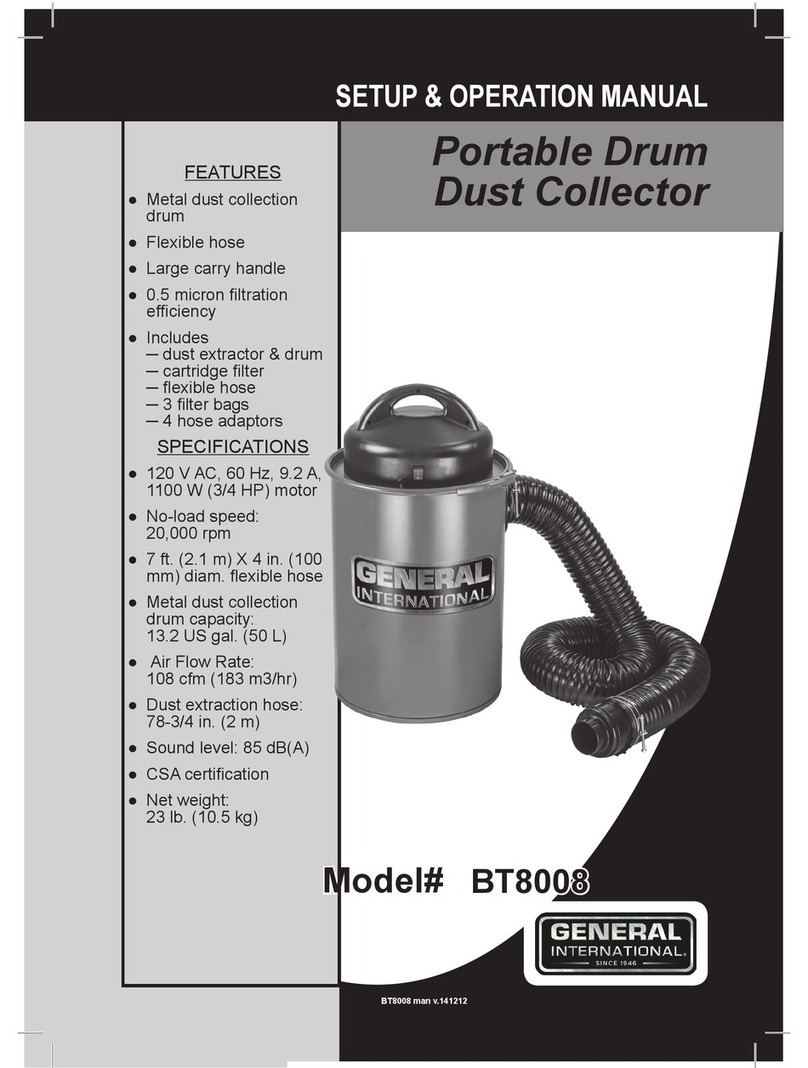
General International
General International BT8008 Setup and operation manual
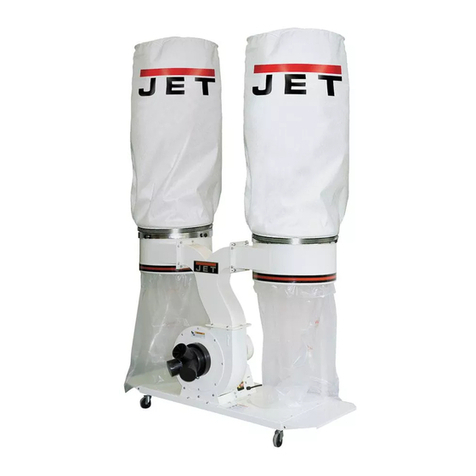
Jet
Jet DC-1900A operating instructions
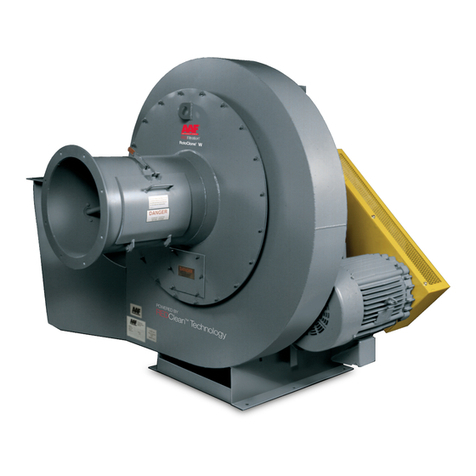
AAF
AAF RotoClone W Installation, operation and maintenance manual

Central Machinery
Central Machinery 61808 Owner's manual & safety instructions

Draper
Draper DE1030H instructions
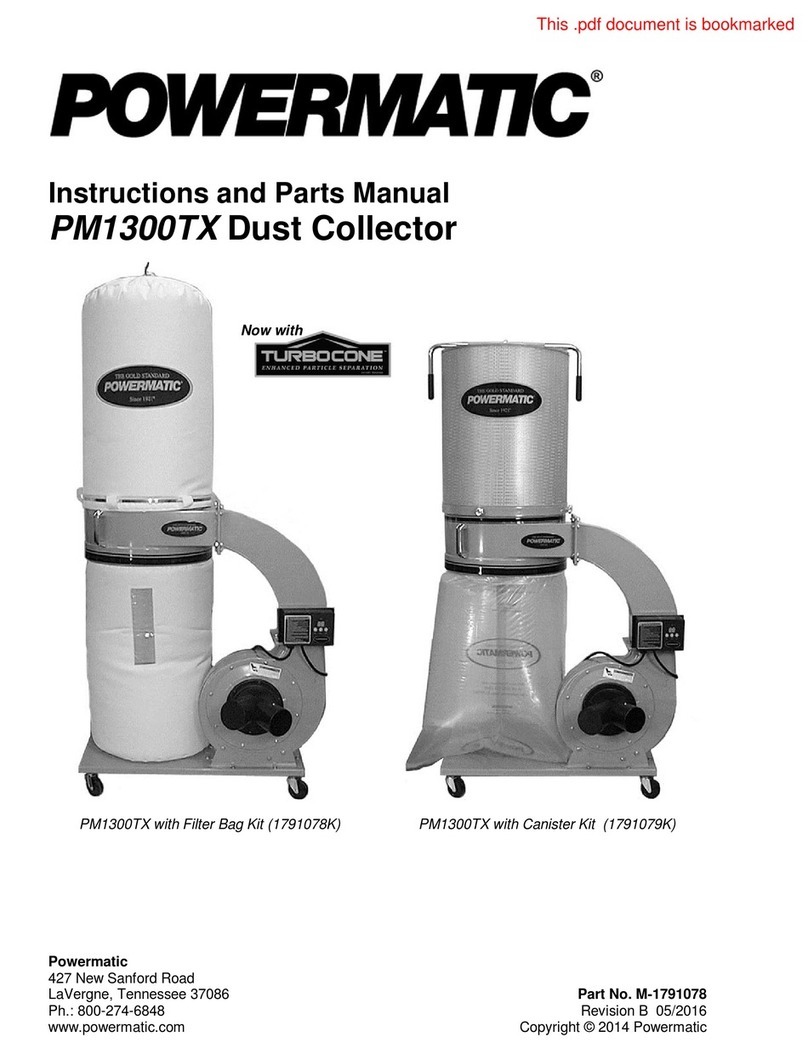
Powermatic
Powermatic PM1300TX-BK Instructions and parts manual
